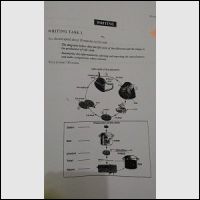The diagrams illustrate silkworms' life cycle and the steps to produce silk cloth. It can be seen that silkworm has 4 stages; egg, silkworm larva, silk thread, and cocoon. Silk cloth, on the other hand, takes 5 steps; selecting, boiling, unwinding, twisting, and weaving.
The first diagram elaborates the circulation of the silkworm. The cycle is begun when moth lay downs eggs in mulberry leaf. After 10 days later, eggs transform to become silkworm larva. In this step, larva consumes mulberry leaf. Larva makes silk thread after 4-6 weeks from the second stage. The forth step, silk thread change perfectly into a cocoon after 3-8 days and it will metamorphose into moth after 3-8 days later.
The second diagram shows how to produce silk cloth. Firstly, it needs to select the cocoon from the fourth stage of silkworm's life cycle. Subsequently, cocoon is put into boiling water. Cocoon can produce 300 - 900 metres of thread after it is unwound in the third step. The fourth step is twisting and dyeing. The last step is to weave thread into cloth. However, it needs another dyeing before cloth ready to use.
The first diagram elaborates the circulation of the silkworm. The cycle is begun when moth lay downs eggs in mulberry leaf. After 10 days later, eggs transform to become silkworm larva. In this step, larva consumes mulberry leaf. Larva makes silk thread after 4-6 weeks from the second stage. The forth step, silk thread change perfectly into a cocoon after 3-8 days and it will metamorphose into moth after 3-8 days later.
The second diagram shows how to produce silk cloth. Firstly, it needs to select the cocoon from the fourth stage of silkworm's life cycle. Subsequently, cocoon is put into boiling water. Cocoon can produce 300 - 900 metres of thread after it is unwound in the third step. The fourth step is twisting and dyeing. The last step is to weave thread into cloth. However, it needs another dyeing before cloth ready to use.

279684_1.jpg
